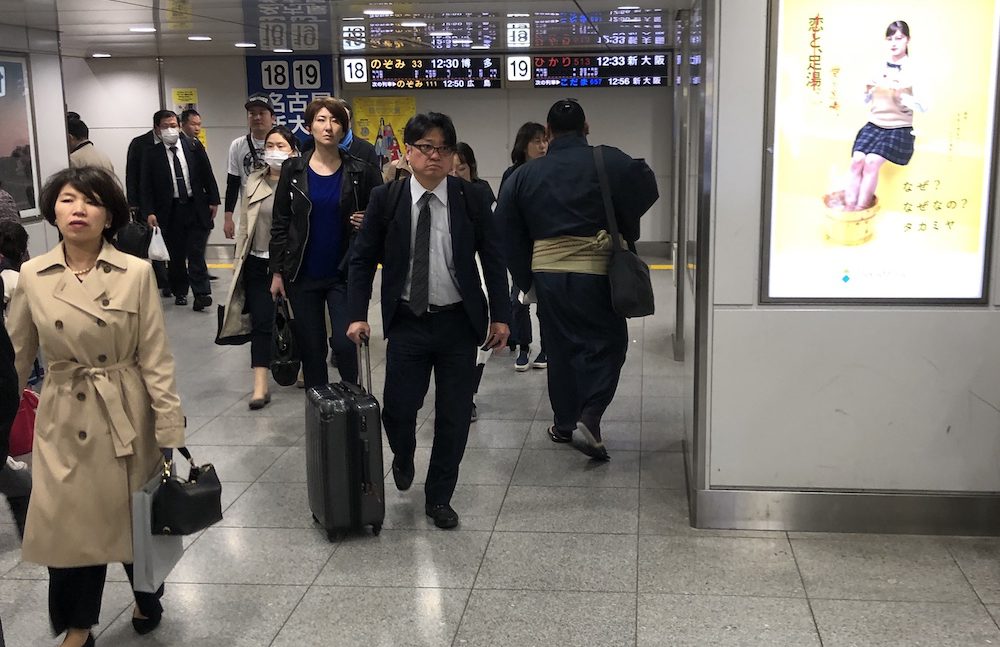|
|
In early April 2019 I was lucky enough to visit Japan for the first time on a family holiday. Our top priority was enjoying the spectacular Japanese scenery with the cherry blossoms in full bloom. 
As the trip unfolded it didn’t take me long to think about what it would be like to be a Human-Centred Designer in Japan and how it compares to Australia. In particular I noticed some aspects of life in Japan that were central to the customer experience.
Japan’s Favourite Design Challenges
- Public Transport – whether it’s the crowded Tokyo metro, Kyoto loop buses, trams in Hiroshima, or Shinkansen bullet trains hurtling across Honshu, the Japanese have made a fine art out of the public transport experience. Their blend of colour, music, signage, courteous locals and helpful support staff has to be experienced to be believed.
- Toilets – This is Japan’s version of ‘building a better mousetrap’. The first billboards you see in Toyko’s Narita airport advertise toilets! As the replacement of traditional ‘squat’ toilets continues in Japan (they are still popular as public toilets as they are seen as more hygienic and require less maintenance), the Japanese have taken the high-tech toilet to another level! The fact that most toilets in homes and hotel rooms require two power points to operate gives you a clue as to how much ‘engineering’ and ‘electronics’ go into them!
- Preserving Traditions – The Japanese love to share their core identity through experiences like tea ceremonies, music, geishas, the samurai, vermillion Shinto tori gates, Buddhist temples, yukata and tatami mats. Values like harmony, respect, purity, and tranquillity are central to their core being and are weaved into their essence as a people.
Japanese Culture

The Japanese people are respectful, considerate, welcoming and polite. We regularly encountered two types of behaviour that I found especially interesting… Courtesy, in the form of ‘random acts of kindness, and Tolerance. These values provide an important backdrop for the design of experiences in Japan.
Random Acts of Kindness
Before we left Australia, people who had been to Japan mentioned how friendly the locals are, and it didn’t take long before we experienced it for ourselves. We tallied up quite a list of ‘random acts of kindness’ from the locals, determined to play their part in delivering us a positive experience. One unexpected example occurred on a busy train in Hiroshima on our way to the Miyajima Island ferry where a local woman saw the four of us trying to find seats together. Taking advantage of the well-designed trains she pressed a lever with her foot that rotated a row of seats 180 degrees allowing the four of us to sit together. She held out her hand and smiled to invite us to sit. By this stage we were well versed in how to show our appreciation both verbally ‘arigato gosaimas’ and non-verbally ‘a deliberate nod of the head’.
It turns out that kindness is infectious, and it wasn’t long before other tourists were also helping us out. For example, when we tried to get a table at a popular sushi restaurant in Ueno, Tokyo there was a queue, a common scenario in such a busy city during cherry blossom season where you can wait for up to two hours! Like many in Japan, the restaurant had a process for taking down your name and how many seats you need, but on this occasion it was a digital interface and with our limited Japanese we had no way of navigating it. A woman in the queue who spoke English and Japanese explained how to use the system so we didn’t stand there all night and go hungry (which would have happened if we used the process incorrectly).
Tolerance
While the Japanese are courteous and considerate towards tourists, I noticed that their courtesy also extends to how they treat one another. There were a number of interesting examples where the Japanese showed incredible tolerance (by Australian standards). This shows a deep commitment to patience and composure and not always putting yourselves first. I’m not confident that the examples below would be tolerated in Australia without some demonstration of frustration or impatience!
The first example was in Hakone where a narrow two-lane road winds it’s way up the river from Odawara. With cherry blossom trees lining the river along the roadside, and a series of popular tourist attractions dotted along the way, there is a constant flow of traffic up and down the mountain. In some places tourist buses can only just pass each other safely. Despite this bus drivers waited patiently to pass solo joggers who had decided to enjoy the sights from the road. Cyclists received similar treatment in a culture that clearly respects the rights of individuals to choose how they want to get from A to B.
The second example is Japan’s makeshift approach to loading zones. As you travel around cities like Toyko and Kyoto you’ll often see cars and vans stopped on the side of the road with their hazard lights flashing. With no other obvious way to stop and unload, it seems to be a tolerated practice and other road users simply make the adjustment required to keep traffic flowing.

At a stop along the way, two international tourists got on with huge bags and loud voices. They clearly hadn’t signed up for the luggage forwarding service like us!
After bumping into a number of travellers they found their seats across from us. In the seat next to them a Japanese woman was trying to get some sleep, a common sight for locals on public transport. Our noisy friends proceeded to debrief their whole trip in loud voices before conducting a hands-free FaceTime call with a colleague in North America that the whole carriage could hear. It was fascinating to watch as the Japanese woman remained calm and did her best to get some rest. At the same time many of the other tourists became visibly irritated, but perhaps influenced by the locals, no one confronted them or gave them any choice advice about their behaviour.
Conclusions
Reflecting on our trip there are certainly some benefits I can see to designing experiences in Japan, and some things that I now realise make it tricky designing experiences in Australia. Here are my main takeaways.
The Benefits of Designing In Japan
- Shared culture and mindset – While there is a steady flow of overseas tourists visiting Japan, in a broad sense Japanese Designers can design for a strong, shared culture of courtesy, respect, empathy, pride and non-judgement.
- Being able to rely on ‘the customer’ and ‘members of the public’ to play their role in delivering your designed experience – Our observations suggest that customers will follow cues in the form of colour-coding, musical prompts and rules like ‘putting your phone on silent while on public transport’ or ‘making seats available for those who need them’. As designers this helps improve both the individual and collective experience in systems like public transport.
Counter Challenges of Designing in Australia
- Low population density and customer volumes – a bullet train from Brisbane to Melbourne has been muted for decades, but compared to Japan, the low volume of commuters makes it hard for the business case to add up.
- A diverse and multi-cultural population with complex and varying belief systems – While we talk about what it means to be Australian (and unAustralian) a fair bit, the song lyric ‘from all the lands on earth we come’ really does ring true. This means that while most of our target customers have an underlying desire to be part of a functional whole, Designers in Australia have to look deeper to find what unites us as human beings to shape the experiences we offer.
Your View?
I’m sure my new perspective will help me be a better Designer wherever I work moving forward! I’d love to hear from other Designers who’ve visited Japan to get your take.



